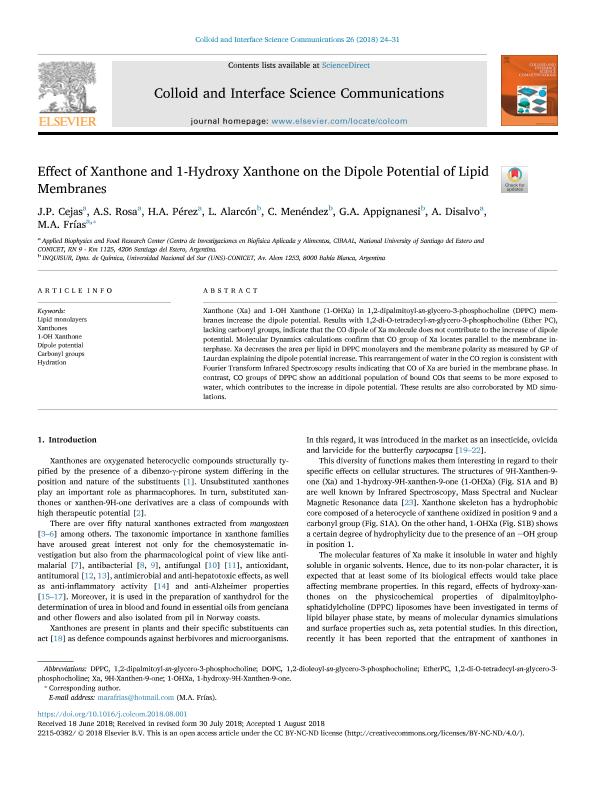Artículo
Effect of Xanthone and 1-Hydroxy Xanthone on the Dipole Potential of Lipid Membranes
Cejas, Jimena del Pilar ; Rosa, Antonio Sebastián
; Rosa, Antonio Sebastián ; Pérez, Hugo Alejandro
; Pérez, Hugo Alejandro ; Alarcon, Laureano Martin
; Alarcon, Laureano Martin ; Menéndez, Cintia Anabella
; Menéndez, Cintia Anabella ; Appignanesi, Gustavo Adrian
; Appignanesi, Gustavo Adrian ; Disalvo, Edgardo Anibal
; Disalvo, Edgardo Anibal ; Frías, María de los Ángeles
; Frías, María de los Ángeles
 ; Rosa, Antonio Sebastián
; Rosa, Antonio Sebastián ; Pérez, Hugo Alejandro
; Pérez, Hugo Alejandro ; Alarcon, Laureano Martin
; Alarcon, Laureano Martin ; Menéndez, Cintia Anabella
; Menéndez, Cintia Anabella ; Appignanesi, Gustavo Adrian
; Appignanesi, Gustavo Adrian ; Disalvo, Edgardo Anibal
; Disalvo, Edgardo Anibal ; Frías, María de los Ángeles
; Frías, María de los Ángeles
Fecha de publicación:
09/2018
Editorial:
Elsevier
Revista:
Colloids and Interface Science Communications
ISSN:
2215-0382
Idioma:
Inglés
Tipo de recurso:
Artículo publicado
Clasificación temática:
Resumen
Xanthone (Xa) and 1-OH Xanthone (1-OHXa) in 1,2-dipalmitoyl-sn-glycero-3-phosphocholine (DPPC) membranes increase the dipole potential. Results with 1,2-di-O-tetradecyl-sn-glycero-3-phosphocholine (Ether PC), lacking carbonyl groups, indicate that the CO dipole of Xa molecule does not contribute to the increase of dipole potential. Molecular Dynamics calculations confirm that CO group of Xa locates parallel to the membrane interphase. Xa decreases the area per lipid in DPPC monolayers and the membrane polarity as measured by GP of Laurdan explaining the dipole potential increase. This rearrangement of water in the CO region is consistent with Fourier Transform Infrared Spectroscopy results indicating that CO of Xa are buried in the membrane phase. In contrast, CO groups of DPPC show an additional population of bound COs that seems to be more exposed to water, which contributes to the increase in dipole potential. These results are also corroborated by MD simulations.
Archivos asociados
Licencia
Identificadores
Colecciones
Articulos (CIBAAL)
Articulos de CENTRO DE INVESTIGACION EN BIOFISICA APLICADA Y ALIMENTOS
Articulos de CENTRO DE INVESTIGACION EN BIOFISICA APLICADA Y ALIMENTOS
Articulos(INQUISUR)
Articulos de INST.DE QUIMICA DEL SUR
Articulos de INST.DE QUIMICA DEL SUR
Citación
Cejas, Jimena del Pilar; Rosa, Antonio Sebastián; Pérez, Hugo Alejandro; Alarcon, Laureano Martin; Menéndez, Cintia Anabella; et al.; Effect of Xanthone and 1-Hydroxy Xanthone on the Dipole Potential of Lipid Membranes; Elsevier; Colloids and Interface Science Communications; 26; 9-2018; 24-31
Compartir
Altmétricas



